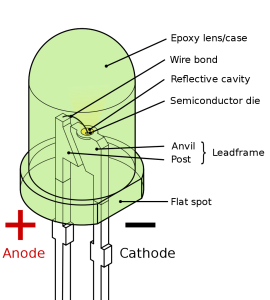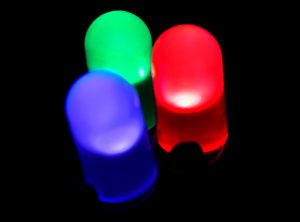Solid State LED Lighting
‘Solid State’ lighting is the name given to LED lights because solid matter produces the light, there are no filaments or gases required.
So many people ask the question, ‘how do led lights work?’, so lets have a look at the workings of LED lighting.
LEDs or Light Emitting Diodes are actually one of the simplest types of semiconductor devices.
A light-emitting diode (LED) is a two-lead semiconductor light source. It is a p–n junction diode that emits light when activated.When voltage is applied to the device, electrons fill in the electron holes in the semiconductor and simultaneously release energy. At the same time the photons (i.e. light), in a process known as electroluminescence.
Tthe color of the light (corresponding to the energy of the photon) is determined by the energy band gap of the semiconductor. LEDs are normally small (less than 1 mm2) and integrated optical components may be used to shape the radiation pattern.
Electron Hole
An electron hole occurs when an atom lacks electrons, which create a negative charge, so the atom has a positive charge. The term ‘Doping’ is used when pure lnGaN does not have any electron holes to carry the electrical current, so companies add impurities, or atoms of another material to create electron holes or free electrons.
LED Lighting The Early Days
The earliest LEDs produced in the early sixties, emitted low-intensity infrared light. Infrared LEDs are still frequently used as transmitting elements in remote-control circuits, such as those in remote controls for many consumer electronics. The first visible-light LEDs were red and had low intensity. Today we can produce very bright LED’s across the visible, ultraviolet, and infrared wavelengths.
 Low Energy Consumption
Low Energy Consumption
LEDs have lower energy consumption, longer lifetime, improved physical robustness, faster switching and are very small, which in many peoples opinion, makes them far superior to incandescent light sources.
LED or Light-emitting diodes are used in the home, aircraft, vehicle headlights, camera flashes, advertising boards and many more.
InGaN
InGaN creates bright blue light, so diodes use this as the comon semiconductor and as with fluorescents, a phosphor coated outer casing being added can create white light.
A number of doides are arranged and wired together, then the outer decorative casing is added. The light from the doides is refracted in certain directions, so LED’s are excellent at directional lighting.
*Call sdl lighting today for a quotation.*
